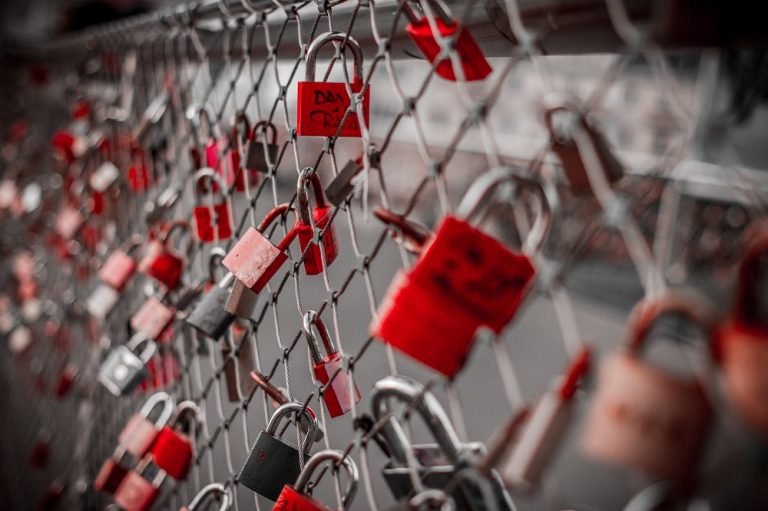Paris has always been known as the City of Love, so it’s no surprise that couples both young and old flock to the city for a romantic vacation. Maybe visit the Eiffel Tower, make the pilgrimage to the Basilique du Sacré-Cœur, and have a candle-lit dinner along the Canal St. Martin. Finish up your trip and seal your unbreakable love with a kiss and a lock left on the Pont des Arts bridge before throwing away the key into the River Seine.
Or, at least, that’s what you could have done had the French government decided against removing all existing love locks and banning future locks on the iconic bridge. And, apparently, plenty of local governments around the world are doing the same thing with public places where love locks are commonly placed.
What Are Love Locks?
Love locks are padlocks placed by couples, sweethearts or just two people in a relationship in either iconic love lock locations or in places where there is significant meaning for the two of them. Often, these couples take an ordinary padlock, inscribe their names, initials, the date they locked their love lock, or their anniversary date onto the lock.
To symbolize that their love is unbreakable and permanent, they throw the key away. Because of this, it’s common to put love locks near a body of water like a river and ceremoniously throw the key away.

Origins, Legends, and Superstition
Love locks are supposedly at least a hundred years old and started on the Most Ljubavi Bridge in the town of Vrnjačka Banja, Serbia, according to an old tale from World War I. The story goes that a local woman fell in love and was engaged to an officer who left to fight in the war in Greece. There, he fell in love with another woman and broke off his engagement to marry her instead. The Serbian woman never recovered and eventually died due to heartbreak.
To prevent meeting the same fate, young women had to write their and their partner’s names on a padlock and lock them on the bridge where the Serbian woman and her former lover used to meet. This is said to make your love stronger or unbreakable.
It’s unclear how this practice spread across Europe and the rest of the world, but by the early 2000’s it was a practice in many locations and is seen in literature and film such as I Want You by Italian author Federico Moccia and the 2013 American film, Now You See Me.
Outside of European and American culture, other cultures have their own meaning for it. In Fengyuan, Taiwan’s railway station, locks are placed in pairs, but not necessarily because of romance. Some locals believe that if you lock a pair of padlocks and make a wish, the magnetic energy of the trains that pass underneath will accumulate in the locks and be strong enough to fulfill one’s wishes. In Montevideo, Uruguay, there is a fountain where locals and tourists can add their love locks with their initials. If the two can return to the fountain together in the future, their love will be unbreakable.
Why More Governments Aren’t Tolerating Love Locks Anymore
While it all sounds so romantic, unfortunately, the government isn’t having it. There are plenty of love lock locations across the world, some even used to bolster tourism from both locals and foreigners. It worked before, when the idea was still relatively new. But with more and more people hopping on board, governments are beginning to see how it backfires.
Some public places can’t support the cumulative weight of locks.
If you’ve ever held a good-quality heavy-duty lock, you know that, despite its size, its material is quite heavy. Carrying one padlock wouldn’t be so hard, but imagine an entire wall of locks dragging down a fence. In 2015, Paris officials began removing all love locks from the Pont des Arts, arguably one of the most iconic love lock locations in the world, because the bridge’s architectural structure was starting to crumble due to the added weight of the locks at around 45 tons.
If you’ve seen how many locks there are, you’d see how easily it went from becoming a sweet gesture to an eyesore on such an iconic bridge. There were so many locks, that it was near impossible to see the iron grill anymore. Newer locks were attached to older locks since there was no more space. It had become such an eyesore to the locals who began avoiding the area and a tourist destination filled with pickpockets and vendors selling cheap padlocks.
Unfortunately, these couples’ love are no greater than the architectural heritage of Paris, and they were taken out. A year later, Paris officials decided to sell off these old love locks and donate the proceeds to homeless refugees.
It’s a form of vandalism.
To reduce the number of people adding their own locks on public monuments and heritage sites, many cities have ruled it as an act of vandalism that was banned. In places where officials have rehabilitated love locks, you’ll find signs discouraging people from adding their own love locks. Places like the Eiffel Tower in Paris, Prague, and Gemany are realizing the effects of padlocks weighing down a monument. Places like Russia have designated places where couples can leave their love locks, but stubborn couples continue to place their own love locks even on prohibited places.
It’s a safety hazard, especially on bridges.
Bridges are an architectural feat, with engineers providing ways for pedestrian or vehicular passage despite its weight. Bridges often have weight limits before it starts to crack or give way, and engineers who build bridges don’t necessarily take into account the added weight of hundreds of locks in various areas.
Should the weight of the locks, and the pedestrians or the vehicles prove to be too much, it may result in the bridge falling down. If located over water or in a high area, people on the bridge may be seriously injured or have a fatal fall. This is another reason why the Pont de Arts bridge was rehabilitated and removed of all locks.

Locks are added garbage to the environment.
Both the keys and the lock are added items that will eventually end up in some landfill. Even worse, these metal keys are thrown into bodies of water, prone to rust and harming the environment of any nearby fishes.
The No Love Lock Movement
Due to these harmful reasons, a “No Lock Movement” is beginning to grow around the world. No love between two people is more important than the historical architecture of a country, so putting a love lock to symbolize the love of you and your partner becomes an unnecessary action. So, concerned citizens in Paris and other countries with a tourism niche for love lock sites are moving towards banning love locks altogether.
While it is a cute and romantic idea, when it comes down to the logistics, architecture, and engineering, these love locks, accumulated, are a hazard to the safety and structural integrity of any public area, especially bridges where love locks are frequent. You don’t need a manufactured piece of metal stuck on a bridge grill to signify your love. And if governments around the world have proven, if you really love your partner, chances are that your relationship will last longer through your actions than with any ordinary padlock.




